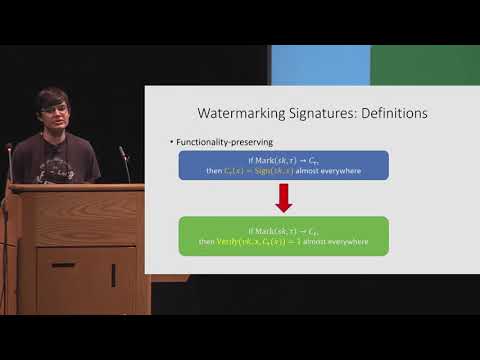CryptoDB
Watermarking Public-Key Cryptographic Primitives
| Authors: | |
|---|---|
| Download: |
|
| Abstract: | A software watermarking scheme enables users to embed a message or mark within a program while preserving its functionality. Moreover, it is difficult for an adversary to remove a watermark from a marked program without corrupting its behavior. Existing constructions of software watermarking from standard assumptions have focused exclusively on watermarking pseudorandom functions (PRFs).In this work, we study watermarking public-key primitives such as the signing key of a digital signature scheme or the decryption key of a public-key (predicate) encryption scheme. While watermarking public-key primitives might intuitively seem more challenging than watermarking PRFs, our constructions only rely on simple assumptions. Our watermarkable signature scheme can be built from the minimal assumption of one-way functions while our watermarkable public-key encryption scheme can be built from most standard algebraic assumptions that imply public-key encryption (e.g., factoring, discrete log, or lattice assumptions). Our schemes also satisfy a number of appealing properties: public marking, public mark-extraction, and collusion resistance. Our schemes are the first to simultaneously achieve all of these properties.The key enabler of our new constructions is a relaxed notion of functionality-preserving. While traditionally, we require that a marked program (approximately) preserve the input/output behavior of the original program, in the public-key setting, preserving the “functionality” does not necessarily require preserving the exact input/output behavior. For instance, if we want to mark a signing algorithm, it suffices that the marked algorithm still output valid signatures (even if those signatures might be different from the ones output by the unmarked algorithm). Similarly, if we want to mark a decryption algorithm, it suffices that the marked algorithm correctly decrypt all valid ciphertexts (but may behave differently from the unmarked algorithm on invalid or malformed ciphertexts). Our relaxed notion of functionality-preserving captures the essence of watermarking and still supports the traditional applications, but provides additional flexibility to enable new and simple realizations of this powerful cryptographic notion. |
Video from CRYPTO 2019
BibTeX
@article{crypto-2019-29919,
title={Watermarking Public-Key Cryptographic Primitives},
booktitle={Advances in Cryptology – CRYPTO 2019},
series={Lecture Notes in Computer Science},
publisher={Springer},
volume={11694},
pages={367-398},
doi={10.1007/978-3-030-26954-8_12},
author={Rishab Goyal and Sam Kim and Nathan Manohar and Brent Waters and David J. Wu},
year=2019
}

